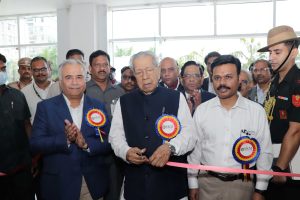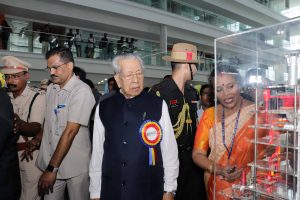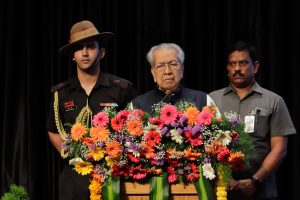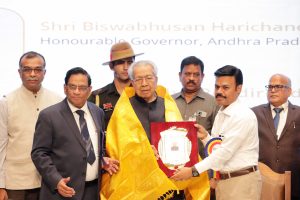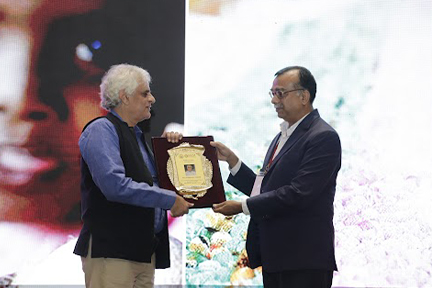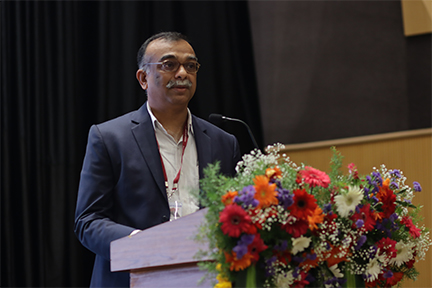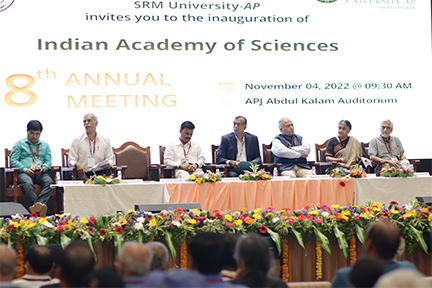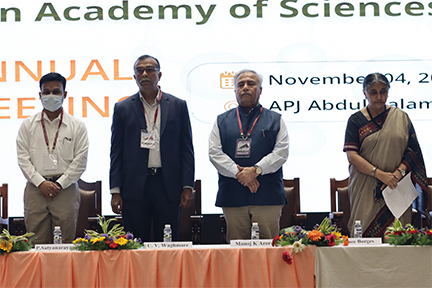Advantages of global immersion programmes in Malaysia
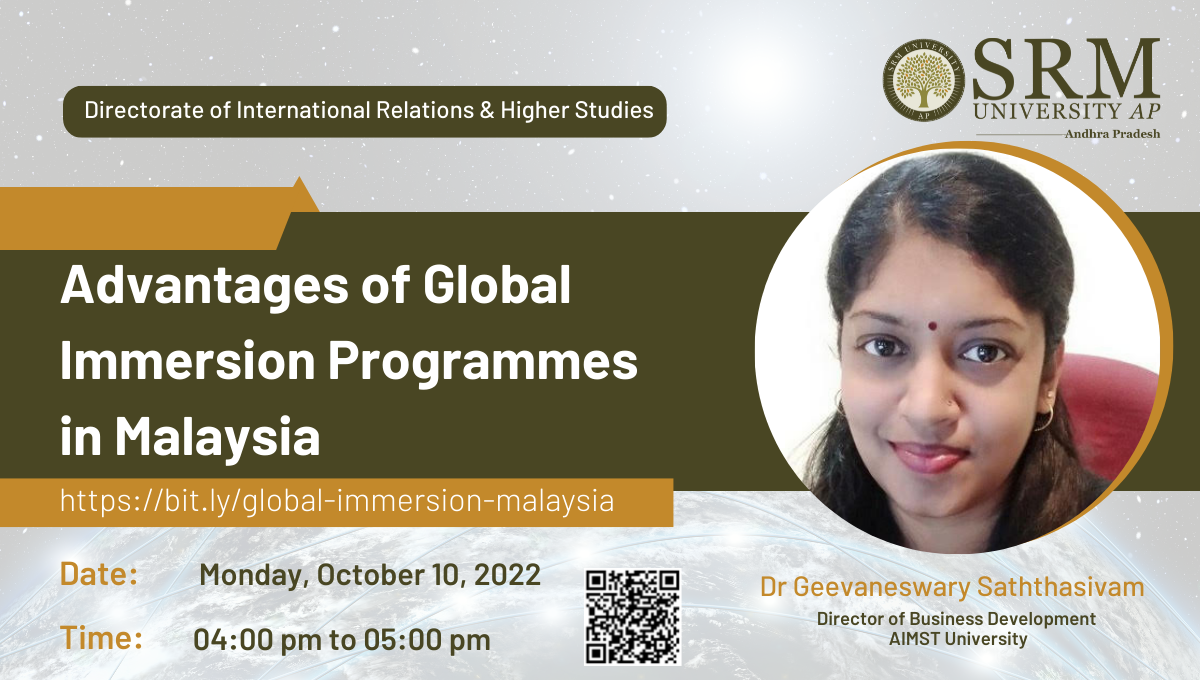 Global Immersion Programme is a unique abroad learning programme instituted at SRM University-AP, enabling students to acquire an all-encompassing learning exposure at an international university. The programme intends to acquaint students with varied approaches of learning while gaining exposure to a foreign cultural, political, and social milieu.
Global Immersion Programme is a unique abroad learning programme instituted at SRM University-AP, enabling students to acquire an all-encompassing learning exposure at an international university. The programme intends to acquaint students with varied approaches of learning while gaining exposure to a foreign cultural, political, and social milieu.
The Directorate of International Relations and Higher Studies is organising a webinar on the topic Advantages of Global Immersion Programmes in Malaysia to give students a brief overview of the Global Immersion Programmes in Malaysia and the benefits of undertaking them. Dr Geevaneswary Saththasivam, Director of Business Development, AIMST University, will be the keynote speaker for the event.
Date: October 10, 2022
Time: 4.00 pm to 5.00 pm
Speaker’s Profile
Dr Geevaneswary Saththasivam was the former lecturer and programme coordinator for UG and PG programmes from the faculty of Business and Management. Prior to that, she has 15 years of industry experience in the fields of Supply Chain Management and Shop Floor Management systems and 4 years of experience working in the field of Project Management in multinational corporations.
Join the webinar to know the prospects of doing global immersion programmes in Malaysia.
- Published in Events, International Relations, IR-Events
‘The modern Kautilya of India’: Dr C Rangarajan on India’s economic development
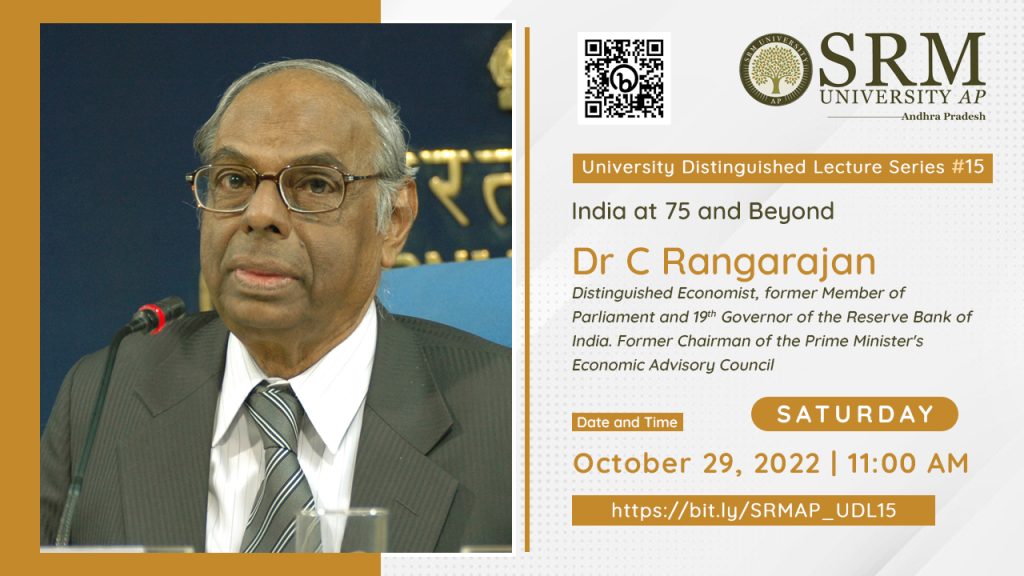 The fifteenth edition of University Distinguished Lecture series on the topic “India at 75 and beyond”, was held on October 29, 2022 to celebrate the magnificent growth displayed by India. The session was addressed by Dr C Rangarajan, renowned economist and former Governor of Reserve Bank of India. The intense and inspiring lecture highlighted the importance of reflection on the past and articulation of our vision for our future to enable rapid progression on economic development.
The fifteenth edition of University Distinguished Lecture series on the topic “India at 75 and beyond”, was held on October 29, 2022 to celebrate the magnificent growth displayed by India. The session was addressed by Dr C Rangarajan, renowned economist and former Governor of Reserve Bank of India. The intense and inspiring lecture highlighted the importance of reflection on the past and articulation of our vision for our future to enable rapid progression on economic development.
Dr C Rangarajan gave a comprehensive outlook on the economic performance of India since independence. “India has made momentous progress on reducing multidimensional poverty. The incidents of multidimensional poverty were almost reduced by half to almost 27.5% during 2005-06 and 2015-16 period due to deeper progress among the poorest. Thus within 10 years, the number of poor people in India fell by more than 270 million, a truly massive achievement,” he stated during the lecture.
Dr Rangarajan further expounded on the importance of reform agendas and measures, the subsisting triad of economic policies and the future challenges of progressing into being a developed nation. The lecture was followed by a Q & A session moderated by Dr S Ananda Rao and Dr Erra Kamal Sai Sadharma from the Department Economics.
Prof Kamaiah Bandi, Dean-School of Liberal Arts and Social Sciences applauded Dr Rangarajan on being a unique distinction of shaping and motivating five generations of intellectual cohort. “Dr C Rangarajan has successfully brought down the gap between theory and practice in his capacity as Governor of RBI and various other important positions he has held for our nation. We as SRM AP look forward to your remarkable experience and knowledge to incubate motivation in our students.”
SRM University-AP has actively promoted a cumulative intellectual ecosystem and interdisciplinary education. “The principal objective of the University Distinguished Lecture series is to impel research scholars, students from all around the world to undertake progressive measures for the holistic development of our nation”, said Honourable Vice Chancellor, Prof Manoj K Arora in his welcome address.
Prof D Narayana Rao, Pro-Vice-Chancellor, SRM University-AP concluded the event by addressing Dr C Rangarajan as ‘the modern Kautilya of India’ and presented a memento on behalf of the institution as a token of respect and appreciation for his esteemed presence at the fifteenth edition of the University Distinguished Lecture series.
Governor Shri Biswabhusan Harichandan inaugurated ISRO & DAE Exhibition in SRM University-AP
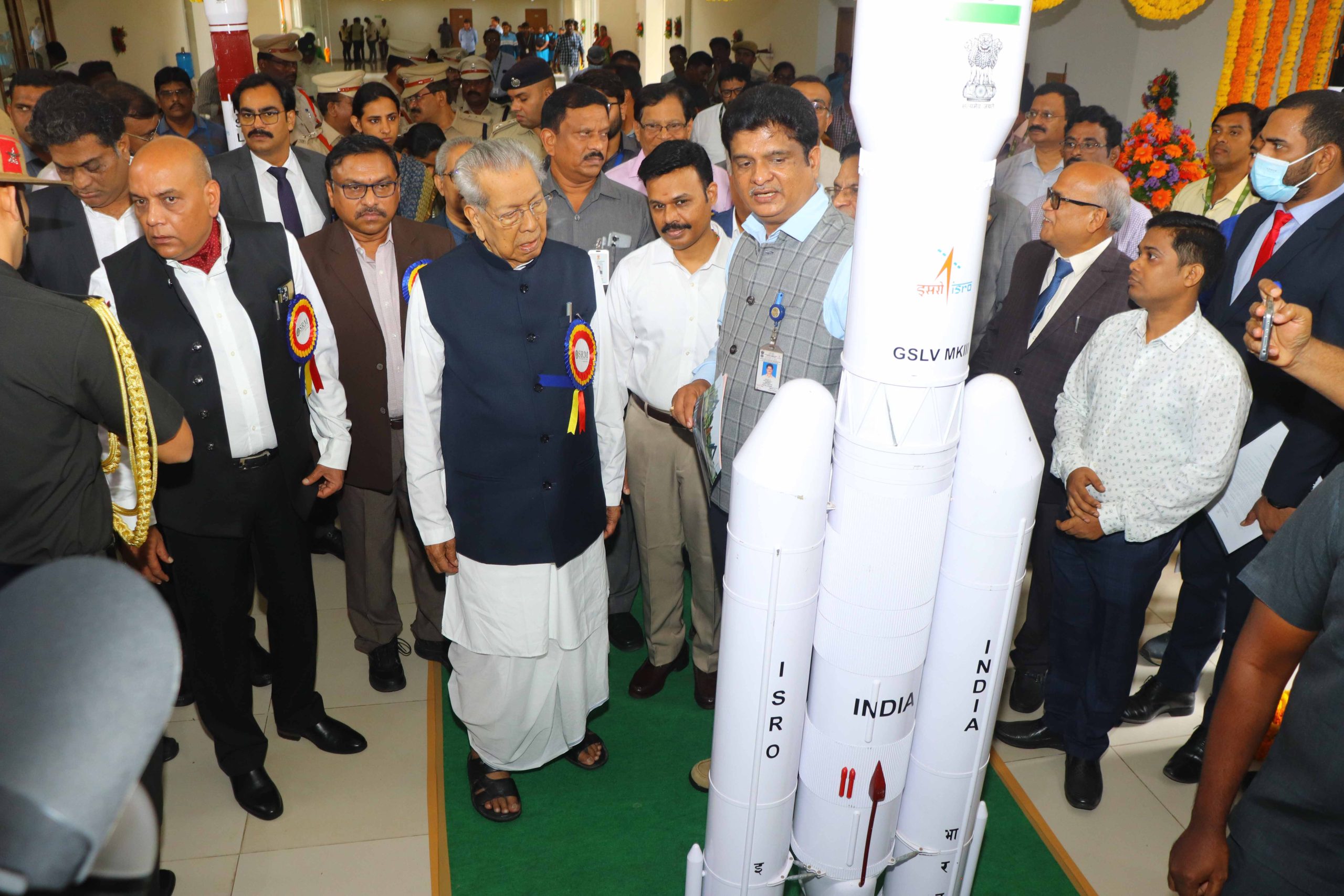 “The societal expectations from science and technology are increasing. Thus, the scientific community has the responsibility to rise to the expectations” said Hon’ble governor to the intellectual gathering.
“The societal expectations from science and technology are increasing. Thus, the scientific community has the responsibility to rise to the expectations” said Hon’ble governor to the intellectual gathering.
Governor of Andhra Pradesh, Shri Biswabhusan Harichandan inaugurated the Science and Technology Exhibition, by ISRO and DAE, at SRM University-AP, Andhra Pradesh, on November 03, 2022. The exhibition, organised as a prelude to 88th Annual meeting of the Indian Academy of Sciences, will be open till November 06 on the campus.
“It is known that science and technology are the established currency of the geo-political world. Any country that has made advances in prosperity has invariably depended on science and technology”, remarked Sri Biswabhusan Harichandan addressing the science and technology enthusiasts from all over the country. He reiterated Prime Minister Shri Narendra Modi’s vision of the nation – “Jai Jawan, Jai Kisan, Jai Vigyan, Jai Anusandhan”. He further said that “a developed nation is one that has the capacity for wealth, literacy, high quality of life and national security . This is your country, be proud of it, go ahead and our great ambition of Athmanirbhar will be fulfilled through each one of us”, to the audience of school students came from different parts of the state to attend the exhibition.
Addressing the gathering, Prof Umesh Waghmare, President of the Indian Academy of Sciences (IASc), emphasized that the important mandate of IASc is to uphold the cause of progress and to connect with society through the domain of science and technology. “I am really excited to associate with the students through the exhibitions and meetings organised at SRM AP”, he added.
Prof Manoj K Arora, Vice Chancellor of SRM University- AP, delivered the welcome address and highlighted the achievements of the university in the past five years. Pro-Chancellor, Dr P Sathyanarayanan emphasised the impact of Campus Social Responsibility for the progress of the country. “It is our proud privilege to host the 88th Annual Meeting of IASc at our university campus”, he added. Pro Vice- Chancellor, Prof D Narayana Rao highlighted the achievements of Indians trained in the Athmanirbhar India. He lauded the proactive application of science and technology and the insatiable quest for research and development in the areas of national priority such as world-class communications and remote sensing satellites.
Dr. Pola Bhaskar IAS, Commissioner of Collegiate Education; SRM AP Registrar and many other dignitaries from Indian Academy of Sciences and State and Central government were present on the inaugural function.
Around 1000 students from different schools across the state participated in the first day of Science and Technology Exhibition. The exhibition aims to be an engaging and invigorating platform for students from various regions.There are demonstration models of rocket energy, space research, and nuclear technology, interactive videos on the evolution of technology in ISRO and DAE, and meetup with renowned scientists and technologists. Participants can converse with eminent scientists and researchers on their pathbreaking research works. Apart from the pioneering research models, the exhibition proffers a brief account of various career opportunities at ISRO and DAE. The exhibition will last for the next four days and will be open to the participants free of cost.
In Media: Press Coverage- Published in News, University Event
88th Annual Meeting of Indian Academy of Sciences begins at SRM University-AP
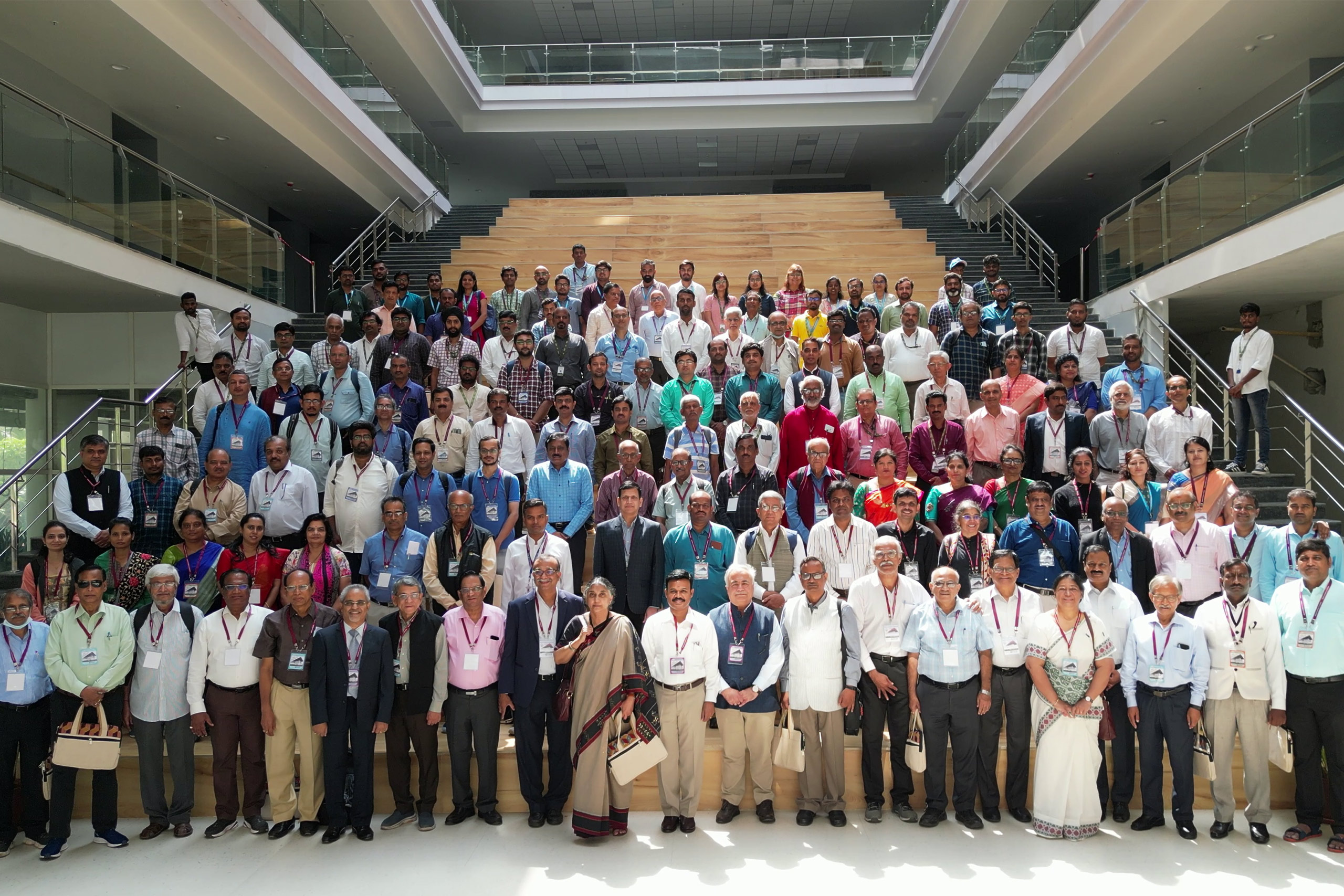
The 88th Annual Meeting of the Indian Academy of Sciences began on Friday, November 04, 2022, at SRM University- AP. The event, which spans three days, features distinguished fellows and associates of IASc and renowned Professors from premier institutions across the country. Prof. Umesh V Waghmare, President of the Indian Academy of Sciences, inaugurated the Annual Meeting with his presidential address on “Instabilities of crystals and their functional properties”.
Prof. Waghmare’s lecture revolved around the usage of fundamental laws of Physics in identifying instabilities in crystals. It also acquainted the audience with how these fundamental concepts hold supreme importance in the development of predictive models that capture interactions between the instabilities and external forces to predict the material-specific functional behaviour of advanced materials. The noteworthy remarks were Illustrated with crystal instabilities of polar phonons, spin-ordering, and strain that drive the functional properties of ferroelectrics, antiferromagnets, and shape memory alloys, respectively.
In his welcome speech, Prof Manoj K Arora, Vice-chancellor of SRM University- AP, requested the fellow and associate members of IASc to encourage and instil their unwavering admiration and inclination for research and development into the faculty of educational institutions. He also expressed his concerns about how science and technology are instructed to students in classrooms; considering the enthusiasm and genuine yearning for innovations; it should evoke among students to retain the potential for constructive explorations in ages to come.
“The things that kept an organisation like ISRO going beyond human imaginations and expectations is the solemn belief in themselves, the teamwork and the right sublime combination of the wisdom of past generations and the innovative outlook of the young generation”, stated Prof D Narayana Rao as he expressed his immense acclamation towards the institutes that constitute to the research and development of the country. He also asserted why discovering basic science matters or should be appreciated as they might get transformed into the theories of tomorrow. He also added that the scientific community is destined to live up to the responsibility and highlighted the need to upgrade intellectual and material prosperity. He also emphasised that educational institutions are the backbone of research and development in a country, and there are eccentric career opportunities for the youth in the coming years.
Pro-Chancellor of SRM University- AP, Dr P Sathyanarayanan, thanked IASc for believing in the university’s calibre to be a host and a part of the initiative. He said that he is expecting around 10000 students to benefit from the event. Furthermore, he elaborated on the potential of industry and academia coming together for the improvement of research and development of the country.
The inauguration was followed by a special lecture on “Uniqueness of plant mitochondria: Relevance to crop improvement and climate change” by A S Raghavendra, University of Hyderabad. Swagata Gupta from IIT Kharagpur chaired the lecture. The session concentrated on the distinct features of plant mitochondria that set them apart from animal mitochondria. The speaker elaborated on how mitochondrial metabolism can help plants to adapt to climate changes in terms of flooding, global warming, and elevated CO2.
Afternoon sessions started with lectures by fellows and associates and were chaired by K Bhanu Sankara Rao, University of Hyderabad. The first lecture by Dr D B Ramachary, University of Hyderabad, on the “Discovery of sustainable organocatalytic reactions: Expansion of substrate/catalysts scope”. Discussed the discovery of in-situ generated novel reactive primary catalytic species. The session also focused on their direct applications in a variety of selective green bond formations to furnish the chiral functionalised molecules, drugs, drug-like molecules, natural products, and pharmaceuticals. The second speaker Aditya Bandyopadhyay from IIT Kharagpur talked about “Electrified fluid interfaces- Waves and pattern formation”. He detailed how Interactions of electric fields at the interface of two fluids can lead to particle agglomeration at interfaces, as applied to DNA motion at the interface of two aqueous solutions.
The second speaker Aditya Bandyopadhyay from IIT Kharagpur talked about “Electrified fluid interfaces- Waves and pattern formation”. He detailed how Interactions of electric fields at the interface of two fluids can lead to particle agglomeration at interfaces, as applied to DNA motion at the interface of two aqueous solutions.
The special lecture was followed by a Symposium on Green energy. Dr Ranjit Thapa, Associate Dean- Sciences, SRM University- AP, introduced the symposium that provided a deep understanding of hydrogen generation, hydrogen fuel cells, and beyond hydrogen. Dr Ashok K Ganguli, IIT, New Delhi, handled the first session of the symposium on “Photoelectrochemical water splitting for green energy”. The key process of converting water into clean and renewable hydrogen fuel by using highly efficient photocatalysis was discussed. Furthermore, the session also underlined the growing interest in suitable semiconductor materials as photocatalysts for efficient photoelectrochemical water-splitting applications. The transformation needed to achieve the goals of the Paris agreement, the necessity of renewable energy, the difference between clean, green, and renewable energy, photocatalysis, and many more interesting areas were covered during the lecture. The next lecture on “Low-carbon biohydrogen: Enabling through biorefinery” was delivered by S Venkata Mohan, IICT Hyderabad, and was followed by another talk on “Electrochemical energy systems: Hydrogen generation and its use in fuel cells” by S Sampath, IISc, Bengaluru. The symposium came to a close with the lecture of Ramendra Sundar Dey, Institute of NanoScience &Technology, Mohali, on “Electrochemical nitrogen reduction reaction for the synthesis of ammonia: A pathway to a green future”.
All the sessions were followed by meaningful discussions and dialogues with distinguished participants. IASc Secretaries Prof Renees Borges, Prof. Vijay Mohanan Pillai, Treasurer Raghunathan V A and many other dignitaries from the Indian Academy of Sciences, Bengaluru and SRM University-AP, Andhra Pradesh, were present at the sessions.
- Published in News, University Event


